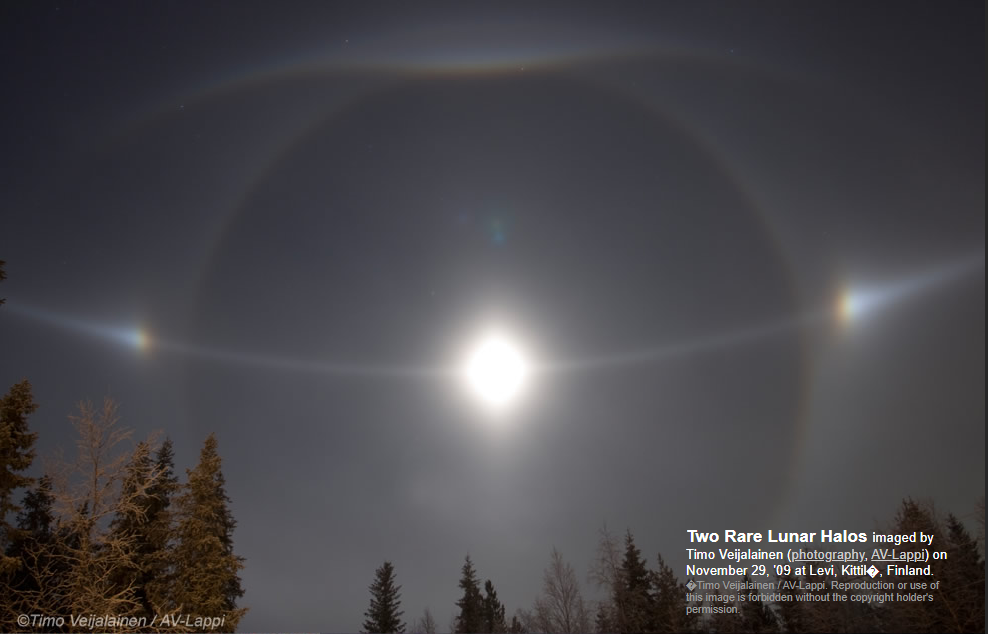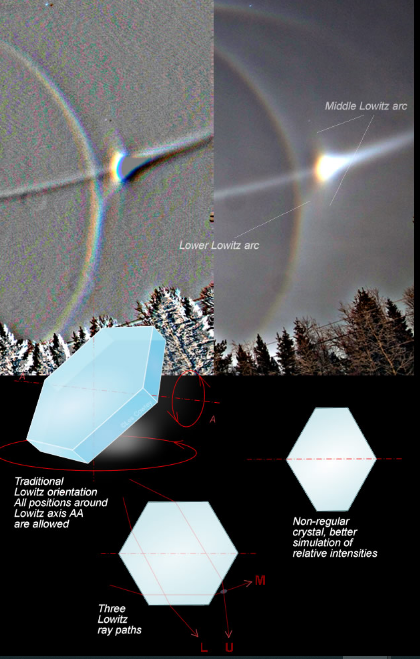Lunar halos, Finland
Lunar Halos: A Rare Atmospheric Phenomenon in Finland
Lunar halos are a captivating atmospheric optics phenomenon that occurs when light from the moon interacts with ice crystals in the Earth's atmosphere. These halos often create stunning displays of light and color, adding a touch of magic to the night sky. One remarkable instance of lunar halos was captured by Timo Veijalainen, a talented photographer, in Levi, Kittilä, Finland. The image reveals not one, but two rare halos, making this display even more exceptional.
The Spectacular Display
Timo Veijalainen's photograph showcases the beauty of lunar halos with remarkable clarity. The image captures the waxing and near-full moon surrounded by two moon dogs, also known as paraselenae. These moon dogs are bright and colorful and are connected by a white paraselenic circle. Above the upper tangent of the 22° circular halo, an extensive upper tangent arc adds to the enchanting scene.
Rare Halos: Parry Arcs and Lowitz Arcs
Among the halos observed in this photograph, there are two particularly rare ones: Parry arcs and Lowitz arcs. The Parry arc, positioned above the upper tangent, is typically seen only once a year above the sun. However, witnessing a lunar Parry arc is an even rarer occurrence.
The Lowitz arcs, on the other hand, appear near each moon dog. These arcs are faintly visible in the unprocessed image but become more apparent in the enhanced versions. Rays passing between 60° inclined side faces of Lowitz-oriented ice crystals can produce up to three arcs. In this particular display, there is a lower arc extending from the 22° halo to the paraselene and a rarer middle arc crossing the moon dog.
Complex Nature of Lowitz Arcs
Understanding Lowitz arcs is no easy task. The traditional model of a regular hexagonal plate-shaped crystal, taking all orientations about the Lowitz axis, struggles to reproduce the complexity observed in this display. HaloSim ray tracings suggest that non-regular hexagons, such as those seen in the image, may better reproduce the relative intensities of the lower and middle arcs.
Furthermore, the orientations of Lowitz arcs might be "plate-Lowitz," meaning that rotational positions about the Lowitz axis are restricted, with those towards the large hexagonal face being more favored. These interpretations are currently a subject of controversy among halo experts, as various other factors can also influence the appearance of Lowitz arcs. There is still much to be understood about these mesmerizing phenomena.
The Role of High-Quality Observations
To unravel the mysteries surrounding Lowitz arcs and other atmospheric optics phenomena, high-quality observations are of utmost importance. By capturing detailed images and collecting data from different locations and conditions, researchers and enthusiasts can contribute to our understanding of these captivating displays.
Conclusion
The lunar halos captured by Timo Veijalainen in Finland provide a glimpse into the extraordinary beauty of atmospheric optics. With two rare halos, including Parry arcs and Lowitz arcs, this display is a testament to the complexity and diversity of these phenomena. While there is still much to learn about the nature of Lowitz arcs, continued observations and research will undoubtedly shed light on their intricacies. So, next time you find yourself gazing at the night sky, keep an eye out for these celestial spectacles that add a touch of wonder to our world.

Two Rare Lunar Halos imaged by Timo Veijalainen (photography, AV-Lappi) on November 29, '09 at Levi, Kittil�, Finland. �Timo Veijalainen / AV-Lappi. Reproduction or use of this image is forbidden without the copyright holder's permission.
The waxing and near-full moon has produced an exceptional display containing two rare halos. Timo Veijalainen captured it in a 27 second exposure at f/4 ISO 200.
Bright and colourful moon dogs (paraselenae) flank the moon and they are linked by a white paraselenic circle. The 22� circular halo is topped by an extensive upper tangent arc.
The first rare halo is the suncave Parry arc at top above the upper tangent. Seen perhaps once a year above the sun, a lunar Parry arc is much rarer,
The even more rare halos are the two variants of Lowitz arcs near each moon dog. Faintly visible in the unprocessed image, they are more apparent in the two enhanced versions at left.
Rays passing between 60� inclined side faces of Lowitz oriented crystals can produce up to three arcs. Here we have a lower arc extending from the 22� halo to the paraselene plus a more rare middle arc crossing the moon dog.
Lowitz arcs are still not straightforward. The traditional model of a regular hexagonal plate shaped crystal taking all orientations about the Lowitz axis has a hard job to reproduce this display. So far, HaloSim ray tracings indicate that the relative intensities of the lower and middle arcs might be better reproduced by non regular hexagons like that at left.
Further, their orientations might be 'plate-Lowitz', i.e. rotational positions about the Lowitz axis are restricted with those towards the large hexagonal face being horizontal more favoured.
These type of interpretations are currently rather controversial among halo experts. All sorts of other effects can play a role. There remains a great deal about Lowitz arcs that we do not understand. More high quality observations can only help.

Note: this article has been automatically converted from the old site and may not appear as intended. You can find the original article here.
Reference Atmospheric Optics
If you use any of the definitions, information, or data presented on Atmospheric Optics, please copy the link or reference below to properly credit us as the reference source. Thank you!
-
<a href="https://atoptics.co.uk/blog/lunar-halos-finland/">Lunar halos, Finland</a>
-
"Lunar halos, Finland". Atmospheric Optics. Accessed on April 19, 2024. https://atoptics.co.uk/blog/lunar-halos-finland/.
-
"Lunar halos, Finland". Atmospheric Optics, https://atoptics.co.uk/blog/lunar-halos-finland/. Accessed 19 April, 2024
-
Lunar halos, Finland. Atmospheric Optics. Retrieved from https://atoptics.co.uk/blog/lunar-halos-finland/.